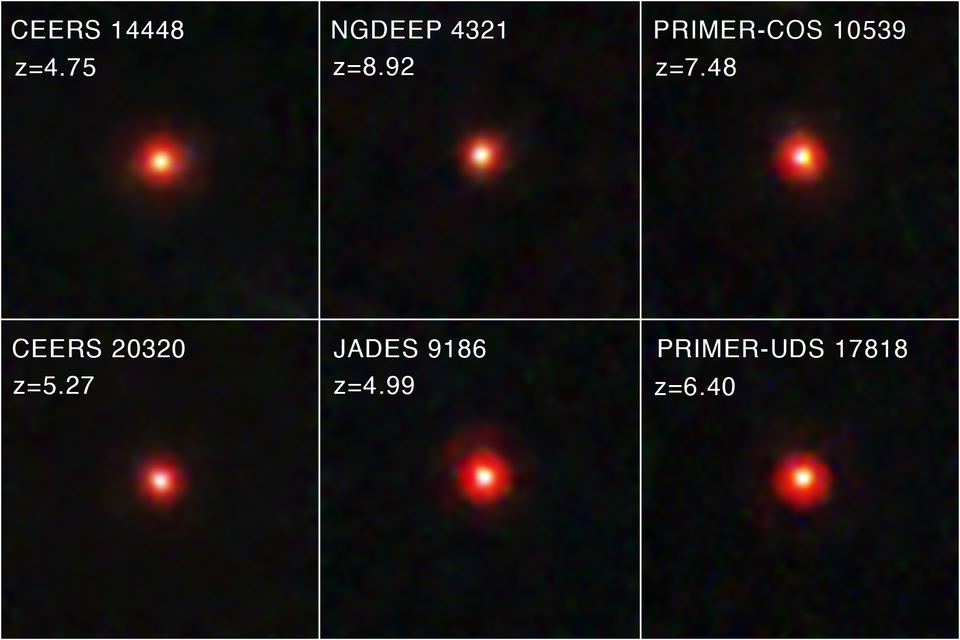James Webb Telescope Unveils Potential Origins of Supermassive Stars

In a groundbreaking discovery, the James Webb Space Telescope (JWST) has identified a series of enigmatic cosmic objects referred to as "Little Red Dots" (LRDs), which may provide crucial insights into the formation of supermassive stars (SMS) and supermassive black holes (SMBHs). These observations, initiated in July 2022, mark a significant advancement in our understanding of the early universe, revealing LRDs that existed merely 600 million years after the Big Bang.
The JWST's capabilities have allowed astronomers to peer further back in time than ever before, uncovering over 300 of these LRDs. Initially perceived as potential galaxies, further analysis has led researchers to propose that these objects are, in fact, primordial SMS—massive stars that could be the progenitors of SMBHs. The research, conducted by Devesh Nandal from the Department of Astronomy at the University of Virginia and Abraham Loeb from the Harvard-Smithsonian Center for Astrophysics, was detailed in a study available on arXiv.org.
According to Nandal and Loeb, "The James Webb Space Telescope (JWST) has unveiled a population of enigmatic, compact sources at high redshift known as 'Little Red Dots' (LRDs), whose physical nature remains a subject of intense debate." Their findings suggest that SMS, with masses around 10^6 solar masses, could have formed exclusively in the early universe, exploding as supernovae that contributed to the creation of early black holes, which evolved into the SMBHs observed today.
The study highlights that LRDs exhibit unique spectral characteristics that challenge existing astronomical models. While initial studies suggested that LRDs were active galactic nuclei (AGN) housing SMBHs, their lack of detectable X-rays and flat infrared spectra prompted a re-evaluation. The researchers developed atmospheric models for SMS and found that these models could accurately replicate the observed luminosity and spectral features of LRDs, aligning with their hypothesis that SMS represent a critical phase in the evolution of the universe.
One of the significant implications of this research is its potential to resolve a long-standing mystery regarding the rapid emergence of SMBHs in cosmic history, which current theories struggle to explain. The LRDs, characterized by their fleeting existence, may embody the direct light from accreting SMS just before their collapse, suggesting they are not merely an anomaly but rather a vital link in the cosmic chain of star and black hole formation.
Furthermore, the research underscores the necessity for continued investigation into the properties and formation pathways of SMS, particularly as it relates to the observed LRD population. The authors advocate for future studies that could explore variations in mass and other attributes of SMS, potentially enriching our understanding of early cosmic structures.
As advancements in telescope technology, like the JWST, continue to unveil the mysteries of the universe, the implications of these discoveries extend beyond mere academic interest. They may reshape our comprehension of cosmic evolution and the fundamental processes that govern the formation of stars and black holes. However, definitive confirmation of these hypotheses may remain elusive, as the LRDs are challenging to observe and are at the very limits of the JWST's capabilities.
In conclusion, while this study does not provide conclusive proof, it lays a crucial foundation for future research aimed at deciphering the origins of supermassive stars and their role in the early universe, potentially answering one of astronomy's most compelling questions. As researchers continue to analyze the data provided by JWST, the astronomical community remains hopeful for further breakthroughs that could eventually confirm the identity of the Little Red Dots.
### References 1. Nandal, D., & Loeb, A. (2025). Supermassive Stars Match the Spectral Signatures of JWST's Little Red Dots. arXiv.org. 2. Williams, L. L. et al. (2024). Analysis of AGN and LRD Spectra. The Astrophysical Journal. 3. Gough, E. (2025). JWST's Discoveries on Early Cosmic Structures. Universe Today.
Advertisement
Tags
Advertisement





